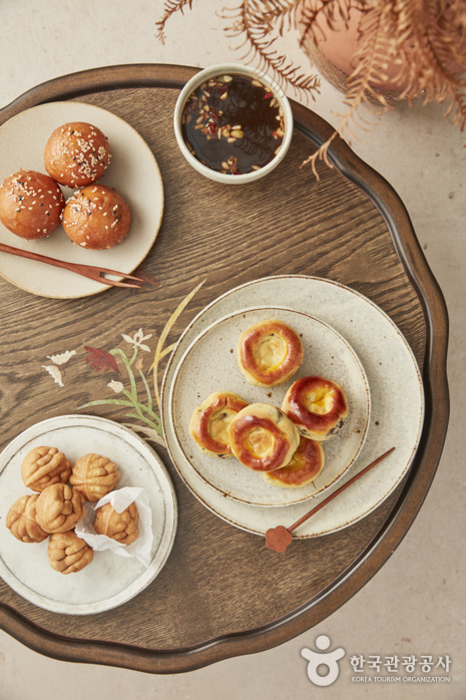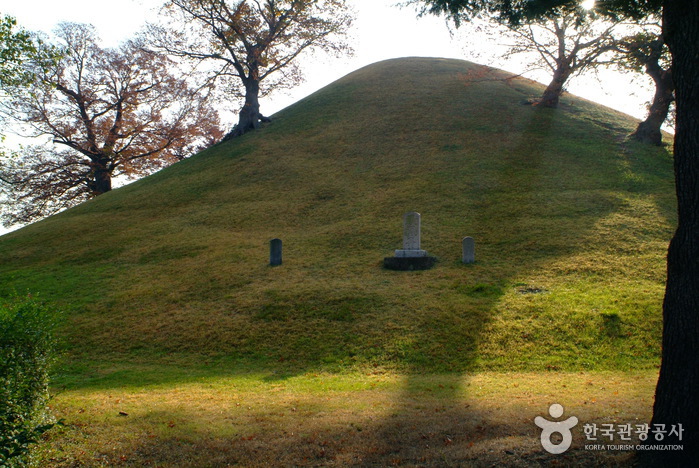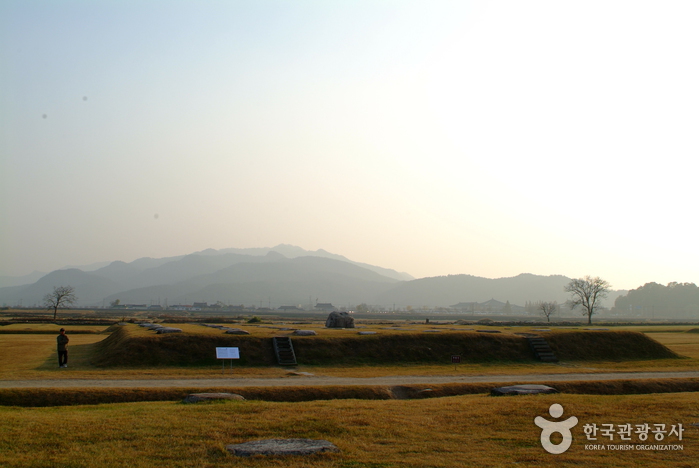Sugyeong Sikdang ([백년가게]숙영식당)
4.8 Km 2 2024-02-23
60 Gyerim-ro, Gyeongju-si, Gyeongsangbuk-do
054-772-3369
Located near the Daereungwon Ancient Tombs in Gyeongju, Sugyeong Sikdang is housed in a renovated old building, featuring ochre-colored exterior walls and a thatched roof that create a folksy ambiance. Its signature dish is chalboribap jeongsik (steamed barley rice set menu), accompanied by doenjang jjigae (soybean paste jjigae). Patrons have the option to customize their bibimbap by adding gangdoenjang (seasoned soybean paste) and gochujang (red chili paste) to their taste. Additionally, the restaurant offers pajeon (green onion pancake) and deodeok muchim (deodeok salad), each prepared using their own secret recipes.
Maison Mini Hotel [Korea Quality]메종미니호텔[한국관광 품질인증]
4.9 Km 0 2023-05-23
24 , Taejong-ro 699beon-gil, Gyeongju-si, Gyeongsangbuk-do
+82-54-745-3232, +82-10-3517-6319
The Maison Mini Hotel in Gyeongju, Gyeongsangbuk-do, is 10 minutes’ walk from both Gyeongju Express Bus Terminal and the famous Hwangnidan Street. Rooms are comfortable and clean - they’re inspected by a room manager before each booking - and bedding is changed every day. There is a luggage storage room and a shared kitchen on the first floor.
REVERTAIN HOTEL GYEONGJU[Korea Quality] / 리버틴호텔 경주[한국관광 품질인증]
4.9 Km 241 2020-12-12
23, Taejong-ro 685 beon-gil, Gyeongju-si, Gyeongsangbuk-do
+82-54-620-8988
Rivertain Hotel Gyeongju is a business hotel that is distinguished by its convenient access and practical facilities, as it is located only 5 min away from Gyeongju Intercity Bus Terminal and 10 min away by foot to Hwanglidangil Street and Daereungwon Ancient Tomb Complex, Cheomseongdae Observatory, Donggung Palace, and Wolji Pond. Gyeongju World Culture Expo Park is also just a 20 min drive away. There are various room types offered, ranging from Standard to Twin, Triple, Suite, Suite Terrace, and Barrier-free. All rooms are furnished with a gray and brown-toned interior for comfort and equipped with premium mattresses, plush handmade goose down bedding, and stylers. In addition to work desks, the rooms are also furnished with a tea table and sofa for conventional tourists as well as business clients. Moreover, Rivertain Hotel Gyeongju is notable for having a full Barrier-free room for unobstructed travel. On-site facilities include a restaurant and a café, where guests can enjoy a 30% discount on coffee. The breakfast table is the hotel’s other source of pride, put together with care and mastery. It is a Korean buffet spread full of delectable dishes, as well as bread, yogurt, fruits, and breakfast cereal.
Hwangnam Bread (황남빵)
4.9 Km 2 2023-07-12
783 , Taejong-ro, Gyeongju-si, Gyeongsangbuk-do
When Hwangnam Bread was created in Hwangnam-dong, Gyeongju, in 1939, people began to refer to it as “the bread from Hwangnam.” Over time, the name stuck. The late Choi Yeong-hwa, the founder of Hwangnam Bread, was a scion of the Gyeongju Choi family who came up with this masterpiece when he was 21 years old after much trial and error. Mr. Choi’s creation is based on the tradition of rice cakes and bread made with sweet red beans, passed down throughout the generations in his family. Even today, 80 years after the creation of the bread, it is only flavored with red beans. Another defining feature of Hwangnam Bread is the delicate comb pattern inspired by the aesthetics of the Silla period.
Surime (수리뫼 [한국전통음식체험교육원])
4.9 Km 22568 2021-01-28
110-32, Poseok-ro, Gyeongju-si, Gyeongsangbuk-do
+82-54-748-2507
Surime is a traditional Korean food experience center owned and operated by Park Mi-suk who studied under Hwang Hye-seong, holder of the Intangible Cultural Property No. 38, Royal Cuisine of the Joseon Dynasty. The institute operates various traditional cooking experience programs open to everyone. The institute shares the walls of the Choi family home, designated as a cultural asset, spanning over 1,652.89 ㎡ with well-preserved hanok structures built over 100 years ago.
Geumgwanchong Tomb (금관총)
4.9 Km 16785 2020-03-18
Noseo-dong, Gyeongju-si, Gyeongsangbuk-do
+82-54-779-6100
Geumgwanchong, located in Noseo-dong, Gyeongju, is a tomb from the Silla Kingdom (B.C. 57∼A.D. 935). It is one of the three tombs that belong to the Noseo-dong Tombs in downtown Gyeongju.
Geumgwanchong Tomb is regarded as the tomb of a king before or after the reign of King Ji-Jeung during the early 6th century (500~514). It is not known exactly to whom this tomb belongs.
It was found in September 1921, when the fief was chopped while a civilian was leveling the ground to widen his building land. The first relic found in this tomb was a gold crown, geumgwan, and so
the tomb took its name. Ornaments such as gold belts, earings, bracelets, saddlers and crockery of the Three Kingdoms Era (when Goguryeo, Baekje and Silla were separated, later unified by Silla in 676 AD) were dug up from the tomb. There were numerous relics, with beaded relics alone numbering over 30,000.
The original structure of Geumgwanchong was 13m high with a 50m diameter. The relics from this tomb were moved and are now
preserved at the Gyeongju National Museum.
Casa Mini Hotel [Korea Quality]까사미니호텔[한국관광 품질인증]
4.9 Km 0 2023-05-23
28, Geumseong-ro 259beon-gil, Gyeongju-si, Gyeongsangbuk-do
+82-54-777-3355
Casa Mini Hotel in downtown Gyeongju, Gyeongsangbuk-do, is a recently-renovated, clean and tidy hotel that’s well positioned for visits to Gyeongju’s historic sites and tourist attractions. Cheomseongdae Observatory, Donggung Palace and Wolji Pond, Woljeonggyo Bridge and Gyeongju National Museum are all within walking distance. Transport links are good too: Gyeongju Intercity Bus Terminal is a 3-minute walk away.
Surime (수리뫼)
4.9 Km 10130 2019-11-21
110-32, Poseok-ro, Gyeongju-si, Gyeongsangbuk-do
+82-54-748-2507
Surime is surrounded by Gyeongju Namsan Mountain, a designated UNESCO World Cultural Heritage Site. Surime serves royal cuisine from the Joseon dynasty, prepared by royal cuisine expert Park Misuk. All dishes are prepared with fresh ingredients grown in the Surime garden for a pure, natural taste. In addition to being a restaurant, guests can also participate in various food programs.
Gyeongju Hwangnyongsa Temple Site (경주 황룡사지)
5.0 Km 21171 2021-01-29
64-19, Imhae-ro, Gyeongju-si, Gyeongsangbuk-do
+82-54-779-6100
Hwangnyongsa Temple Site is located in front of Bunhwangsa Temple in Guhang-dong, Gyeongju. During the Silla Era, the Hwangnyongsa Temple was the nation’s largest temple and housed the bulk of the country’s major Buddhist treasures.
Construction of the temple began in 553 on a field east of the royal compound under the commission of King Jinheung. The king originally planned to build a palace, but decided to build a temple instead, after receiving reports that a yellow dragon had been spotted on the building site. The temple was thus named Hwangnyongsa (Temple of Yellow Dragon) and was completed in 569, seventeen years after construction began. The temple murals featured an old pine tree drawn by Artist Solgeo. During the Silla Era, the temple was the center of state-sanctioned Buddhism.
Later, when monk Jajang was studying in China during the Tang dynasty, he came across a god as he was passing by Taihe Pond. The god said to him, “The yellow dragon, which is my eldest son, is guarding Hwangnyongsa Temple upon orders of Brahma, the Creator. If you build a nine-story pagoda upon your return to Silla, the neighboring states will surrender and pay tribute, and the royal cause will be stronger. Once the construction of the pagoda is complete, prepare a memorial service for the local gods and pardon any of the country's criminals. If you follow all I have told you, no other state will dare invade Silla.”
After this encounter, Jajang returned to Silla and convinced Queen Seondeok to build the nine-story pagoda. Master architect Abiji of the neighboring state Baekje designed the pagoda and the project was built by Yongchun and 200 men using wood and stone. The night before the columns were to be erected, Architect Abiji of Baekje dreamed of the fall of Baekje and refused to complete the project. With a peal of thunder, an old monk and a man of great strength suddenly appeared from the temple's main hall, erected the columns, and magically disappeared. Abiji was so shocked at the sight that he accepted his country’s future demise as the fate of the gods and once again restarted work on the temple. (From Samgungnyusa, the Memorabilia of the Three Kingdoms)
In the twenty-three years following the completion of the pagoda, Queen Seondeok unified the Three Kingdoms; later, numerous scholars pointed to the pagoda as a contributing factor in the unification. Of the three treasures of Silla, two were located at Hwangnyongsa Temple. The largest bell of Silla was also in the temple, but was taken away during the Mongol invasion. The highest monks of Silla preached at the temple, and many kings came to listen to the Buddhist teachings.
During excavation work in July 1969, the massive foundation stones of the sermon hall, auditorium, and pagoda were found. Eight years of archaeological excavations and studies revealed the unique layout of the temple grounds, which consisted of one pagoda and three halls; also found were 40,000 or so ancient artifacts. Though foundation stones and other structures from the bottom of the temple were identified through excavation, there are no historical clues about the temple’s upper design, making the restoration of the temple in its entirety practically impossible. The size of the temple, based on archeological findings, was about 70 acres, roughly eight times larger than that of Bulguksa Temple.
Blau [Korea Quality]블라우[한국관광 품질인증]
5.0 Km 0 2023-05-23
31 , Taejong-ro 699beon-gil, Gyeongju-si, Gyeongsangbuk-do
+82-10-8590-5808
Blau is a stylish guest house on Hwangnidan-gil, Gyeongju, Gyeongsangbuk-do, whose wooden furniture and signature blue coloring inside and out (‘blau’ is German for ‘blue’) give it a strong European vibe. The first floor lounge has the feel of a spacious cafe. Blau is 5 minutes’ walk from Gyeongju Express Bus Terminal. Luggage storage and a free breakfast can be provided, but guests should ask in advance.
![Sugyeong Sikdang ([백년가게]숙영식당)](http://tong.visitkorea.or.kr/cms/resource/20/3034320_image2_1.jpg)
![Maison Mini Hotel [Korea Quality]메종미니호텔[한국관광 품질인증]](http://tong.visitkorea.or.kr/cms/resource/78/2949378_image2_1.jpg)
![REVERTAIN HOTEL GYEONGJU[Korea Quality] / 리버틴호텔 경주[한국관광 품질인증]](http://tong.visitkorea.or.kr/cms/resource/41/2652441_image2_1.jpg)

![Surime (수리뫼 [한국전통음식체험교육원])](http://tong.visitkorea.or.kr/cms/resource/98/1967598_image2_1.jpg)

![Casa Mini Hotel [Korea Quality]까사미니호텔[한국관광 품질인증]](http://tong.visitkorea.or.kr/cms/resource/62/2949262_image2_1.jpg)


![Blau [Korea Quality]블라우[한국관광 품질인증]](http://tong.visitkorea.or.kr/cms/resource/10/2949210_image2_1.jpg)
 English
English
 한국어
한국어 日本語
日本語 中文(简体)
中文(简体) Deutsch
Deutsch Français
Français Español
Español Русский
Русский